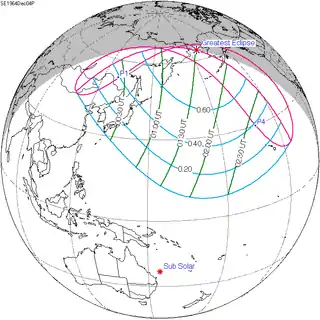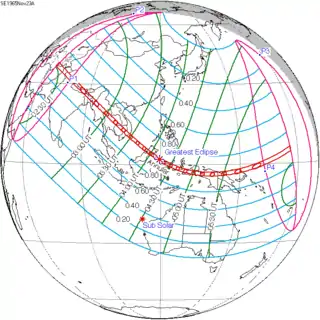| Solar eclipse of November 2, 1967 | |
|---|---|
 Map | |
| Type of eclipse | |
| Nature | Total |
| Gamma | 1.0007 |
| Magnitude | 1.0126 |
| Maximum eclipse | |
| Duration | - |
| Coordinates | 62°00′S 27°48′W / 62°S 27.8°W |
| Max. width of band | - km |
| Times (UTC) | |
| Greatest eclipse | 5:38:56 |
| References | |
| Saros | 152 (10 of 70) |
| Catalog # (SE5000) | 9437 |
A total solar eclipse occurred on November 2, 1967. A solar eclipse occurs when the Moon passes between Earth and the Sun, thereby totally or partly obscuring the image of the Sun for a viewer on Earth. A total solar eclipse occurs when the Moon's apparent diameter is larger than the Sun's, blocking all direct sunlight, turning day into darkness. Totality occurs in a narrow path across Earth's surface, with the partial solar eclipse visible over a surrounding region thousands of kilometres wide.
This total eclipse was very unusual in that it was NON-CENTRAL and did NOT have a central line nor a southern path limit. Instead, over half of the umbral shadow fell off into space throughout the eclipse. Gamma had a value of −1.0007.
This was the first of 55 umbral solar eclipses of Solar Saros 152. The 1st was in 1967 and the 55th will be in 2941. The total duration is 974 years.
Related eclipses
Solar eclipses of 1964–1967
This eclipse is a member of a 1964–1967 series at alternating nodes every 6 synodic months.
Note: Partial solar eclipses on January 14, 1964 and July 9, 1964 belong to the previous lunar year set.
| Solar eclipse series sets from 1964–1967 | ||||||
|---|---|---|---|---|---|---|
| Ascending node | Descending node | |||||
| Saros | Map | Gamma | Saros | Map | Gamma | |
| 117 |  1964 June 10 Partial | −1.13926 | 122 |  1964 December 4 Partial | 1.11929 | |
| 127 |  1965 May 30 Total | −0.42251 | 132 |  1965 November 23 Annular | 0.39061 | |
| 137 |  1966 May 20 Annular | 0.34672 | 142 |  1966 November 12 Total | −0.33001 | |
| 147 |  1967 May 9 Partial | 1.14218 | 152 |  1967 November 2 Total (non-central) | −1.00067 | |
Notes
References
- Earth visibility chart and eclipse statistics Eclipse Predictions by Fred Espenak, NASA/GSFC
.jpg.webp)

